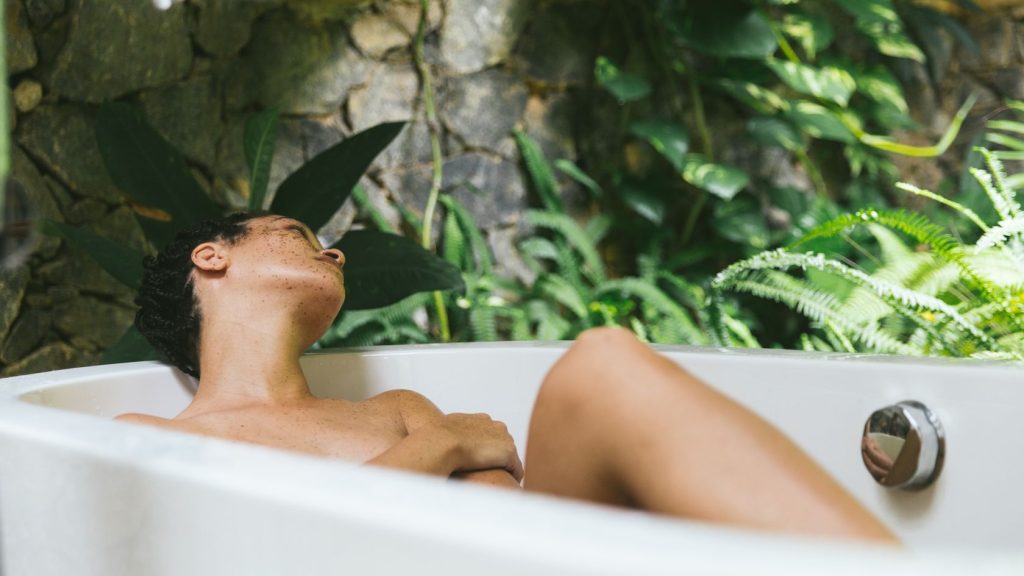Breathing Techniques and Mindfulness During Bathing to Alleviate Anxiety

Unlocking Serenity Through Mindfulness
Amid the hustle and bustle of life in Nigeria, finding moments of tranquility can feel elusive. Many people experience the relentless demands of work, family responsibilities, and societal expectations, leading to heightened stress and anxiety. Consequently, the simple act of bathing can be transformed into a sacred ritual, one that offers an ideal opportunity to incorporate breathing techniques and mindfulness practices. These strategies are not only effective for relaxation; they can also significantly alleviate anxiety while promoting a sense of well-being.
Why Focus on Breathing and Mindfulness?
Numerous studies underscore the profound connection between our bodies and minds, revealing how physical practices influence mental health. When combined with the soothing environment of warm water, mindfulness techniques can further enhance our well-being. Engaging in these practices while bathing can create a personal oasis of comfort. Consider these key benefits:
- Stress Reduction: Mindful breathing promotes relaxation and decreases cortisol levels, the hormone responsible for stress. This can be especially beneficial after a long day navigating the challenges of urban life in cities like Lagos or Abuja.
- Enhanced Focus: Practicing mindfulness helps draw your attention to the present moment, effectively moving away from overwhelming, anxiety-inducing thoughts about the future or past. This concentrated focus can be a powerful antidote to the distractions of daily life.
- Improve Mood: Consistent practice of mindfulness can elevate your overall emotional state and foster a more positive outlook on life. Individuals who incorporate these strategies often report a greater sense of joy and satisfaction.
By exploring simple yet powerful techniques, such as deep diaphragmatic breathing or guided visualization, anyone can create an oasis of calm in their daily routine. For instance, imagine closing your eyes and envisioning a serene beach in the Niger Delta while inhaling deeply, allowing the warm air to fill your lungs, and exhaling slowly to release any tension. This mental imagery, paired with focused breathing, can lead to a significant shift in mental health and emotional resilience.
Practical Steps You Can Take
This article will delve into effective breathing techniques and mindfulness practices that you can adopt in your bathing ritual. One practical method is the “4-7-8” breathing technique: inhale through your nose for a count of four, hold your breath for a count of seven, and then exhale through your mouth for a count of eight. This exercise not only calms the mind but also encourages relaxation of the body, which is essential during a warm bath.
In addition, incorporating essential oils such as lavender or eucalyptus can enhance the sensory experience, further anchoring you in the present moment. These calming scents paired with mindful breathing can initiate a journey towards lasting peace of mind, serving as a reminder that serenity is just a breath away.

As we explore these strategies together, the potential for personal growth and mental clarity unfolds, reinforcing that, even in the busiest of environments, finding a peaceful sanctuary is entirely within your reach.
RECOMMENDED: Check out this similar article
Transforming Bath Time into a Mindful Escape
Bathing is often an overlooked ritual in the whirlwind of daily activities, yet it holds immense potential for fostering mindfulness and alleviating anxiety. The warm embrace of water, coupled with intentional breathing, allows individuals to disconnect momentarily from the chaos surrounding them, creating a space for reflection and relaxation. To maximize the benefits from your bathing experience, integrating specific breathing techniques and mindfulness practices can significantly enhance mental clarity and emotional resilience.
Understanding the Power of Breathing Techniques
Breathing is an innate process, yet many of us are unaware of how altering our breath can profoundly impact our emotional state. By practicing structured breathing techniques during a bath, you can activate the body’s relaxation response and soothe your mind. One popular method is the “box breathing” technique, which involves inhaling, holding, exhaling, and pausing – each for a count of four. This rhythmic approach can ground you, making it easier to release negative thoughts and feelings.
For example, as you settle into the warm water, you might quietly count: inhale for four seconds, hold it for four seconds, exhale for four seconds, and pause for another four seconds. Repeating this cycle fosters a sense of balance and stability, making it particularly effective for those grappling with anxiety. Studies show that controlled breathing can lower heart rates and reduce feelings of panic, making this technique especially beneficial after a stressful day.
Setting the Scene for Mindfulness
To amplify the impact of your breathing practice, creating a calming atmosphere during your bath is crucial. You can achieve this through various elements:
- Lighting: Dim the lights or use candles to create a serene environment that promotes relaxation.
- Heat: Ensure the water temperature is comfortable; the warmth enveloping your body enhances the sensory experience and aids relaxation.
- Scent: Incorporating aromatic elements, such as lavender or lemongrass essential oils, serves to anchor your mindfulness practice and stimulate the senses. The calming properties of these scents can trigger positive emotional responses.
Once you have created your tranquil bathing atmosphere, focus on incorporating mindfulness into the experience. Allow your thoughts to dissipate as you concentrate on the sensations of the water against your skin, the scents wafting through the air, and the sound of water splashing gently. This practice encourages you to embrace the present moment fully, diverting your mind from invasive worries and establishing a sense of clarity.
The merging of breathing techniques with mindfulness during bathing can transform an ordinary daily routine into a powerful tool for emotional healing and self-care. By actively engaging with your breath and the physical sensations of the bath, you create an effective mechanism to combat anxiety. This simple yet impactful practice can become an invaluable part of your self-care routine, fostering resilience even amidst Nigeria’s dynamic lifestyle.
| Advantages of Breathing Techniques | Mindfulness Benefits |
|---|---|
| Stress Reduction | Enhances focus and clarity, helping you fully immerse in the bathing experience. |
| Improved Oxygen Flow | Increases emotional regulation by promoting a sense of calm and safety. |
| Heightened Awareness | Encourages mindfulness practice which translates to daily activities beyond bathing. |
Embracing mindful bathing combined with effective breathing techniques fosters an environment conducive to emotional relief. By focusing on stress reduction, one can harness the calming properties of warm water while engaging in deep, intentional breaths. This practice is not just about physical relaxation; it serves to improve oxygen flow, enhancing overall mental clarity and emotional stability.Moreover, heightened awareness through mindfulness techniques significantly aids in emotional regulation. This practice encourages individuals to observe their thoughts and feelings without judgment, promoting a lasting sense of safety and serenity. The fusion of these elements not only enhances the bathing ritual but also offers tools one can carry into ordinary life, facilitating anxiety alleviation in various scenarios. Explore how integrating these practices into daily routines could transform both your bathing experience and your overall mental health.
YOU MAY ALSO LIKE: Read read another article
Integrating Mindful Practices into Your Routine
While breathing techniques are essential for alleviating anxiety during bathing, the practice of mindfulness enhances your ability to remain present and engaged in the moment. In Nigeria, where fast-paced living often leads to increased stress and occasional overwhelm, adopting rituals that promote well-being is vital. Incorporating mindful practices into your bathing routine can greatly improve the self-care experience, transforming it into a healing sanctuary.
Engaging the Senses
One of the key elements of mindfulness is the full engagement of your senses. During your bath, pay attention to what you can see, hear, feel, smell, and even taste. This sensory involvement can be incredibly grounding. For instance, consider the visual element; perhaps you fill your bath with colorful bath bombs or flowers native to Nigeria, such as hibiscus or bougainvillea. The vibrant colors can evoke feelings of joy and tranquility, providing an instant boost to your mood.
- Sight: Focus on the colors and movements of the water, noticing how the light plays off its surface.
- Sound: Listen to the soothing sound of water splashing, or incorporate soft music or natural sounds, such as birdsong or rain, to create an immersive atmosphere.
- Touch: Notice the sensations of water enveloping you, varying temperatures on different parts of your skin, and how relaxation gradually flows through your body.
- Smell: Use natural scents like eucalyptus or citrus essential oils; they can help to invigorate your mind and alleviate feelings of anxiety.
Visualization Techniques
Visualization can also play a significant role in enhancing mindfulness during your bathing experience. As you immerse yourself in the warm water, visualize any negative thoughts or worries dissolving and being carried away by the water. This technique can act as a symbolic cleansing, allowing you to let go of what no longer serves you. Imagine the water as a protective barrier, shielding you from external pressures and stressors. A powerful visualization practice might involve picturing a peaceful landscape, perhaps a serene Nigerian beach or a lush green forest, transporting yourself mentally to a place where you feel safe and calm.
The Mind-Body Connection
Fostering a strong mind-body connection is critical in alleviating anxiety. When bathing, focus on your breathing as it interplays with the physical sensations throughout your body. By taking deep breaths, feel how the expansion and contraction of your chest echo in the water’s rhythm. This conscious awareness can strengthen the bond between the mind and body, reinforcing the notion that both are integral to emotional wellness.
Moreover, integrating gentle stretches or yoga poses while in the water can enhance this mind-body synchronicity. Simple movements, such as reaching your arms overhead or twisting side to side, can relieve tension and amplify feelings of relaxation. Just as in other aspects of life, small adjustments can make significant differences in your overall emotional and mental well-being.
To maximize the calming effects of your bathing ritual, consider establishing a specific routine that incorporates these various elements. Whether you choose to bathe in the morning to set a positive tone for your day or in the evening as a wind-down ritual, consistency allows your mind and body to anticipate this moment of self-care and relaxation.
As you explore the integration of breathing techniques and mindfulness into your bathing routine, you will likely discover new depths of tranquility and emotional stability. Each session can become a mini-vacation, a necessary retreat from the busyness of life where mental clarity and peace reside.
CHECK OUT: Click here to explore more
Conclusion: A Transformative Approach to Alleviating Anxiety
In a rapidly evolving world where life’s demands often lead to heightened stress and anxiety, breathing techniques and mindfulness during bathing emerge as powerful tools for rejuvenation and emotional balance. By transforming your bathing ritual into a holistic practice, you consciously promote your well-being while embracing the sensory elements surrounding you. This integration of mindfulness not only enriches your bathing experience but also contributes to a greater sense of tranquility and clarity in your daily life.
The practice of engaging your senses—be it through the vibrant visuals of your bathing space, the soothing sounds of flowing water, or the calming scents of essential oils—offers an innovative way to anchor yourself in the present moment. Coupled with visualization techniques that allow you to let go of burdensome thoughts, each bath can function as a cleansing ceremony, refreshing both the mind and body.
Furthermore, developing a robust mind-body connection through focused breathing and gentle movements enhances the calming effects of your ritual. Through consistency and intention, you can establish a sanctuary of relaxation that fits seamlessly into your routine, whether it is a morning energizer or an evening unwind. In essence, embracing these mindful practices can illuminate paths to personal serenity and emotional resilience, allowing you to face life’s challenges with renewed strength.
As you explore the profound benefits of mindfulness and breathing techniques during bathing, consider this transformative self-care practice not just a luxury but a necessity. With persistence and mindfulness, you have the potential to cultivate not only a more peaceful moment in your day but also a lasting impact on your overall mental health and well-being.



